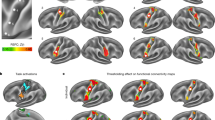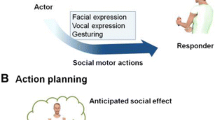Abstract
This paper describes a variety of motor release phenomena, including manual grasping and groping, imitation behavior, utilization behavior, and alien hand sign, their clinical manifestations, and proposed neural mechanisms. One of these specific neurobehavioral disorders, initially described by Lhermitte (Brain [1983] 106: 237–255), and termed utilization behavior, is addressed in more detail. Patients with this disorder are described as reaching out and using objects in the environment in an automatic manner. The current paper provides a comprehensive review of studies that have documented utilization behavior in individuals with a variety of pathologies, all having a specific predilection for the frontal lobes and frontal-striatal systems. Goldberg's (Behavioral and Brain Sciences [1985] 8: 567–616) theoretical framework for understanding motor release phenomena, which conceptualizes these behaviors as resulting from an imbalance between proposed medial (voluntary, goal directed, and future directed) and lateral (automatic, stimulus bound, and visually based) motor systems, is also discussed. Utilization behavior may prove to be a common underlying cause of high levels of excessive and intrusive motor behaviors within various clinical populations. A more comprehensive understanding of the neural systems underlying utilization behavior may prove highly useful for the differential diagnosis of conditions involving the mesial frontal cortex and fronto-striatal connections. Recent studies have started to investigate utilization behavior in clinical populations with known or suspected frontal system dysfunction, including adult patients with a variety of psychiatric conditions and children with ADHD.
Similar content being viewed by others
REFERENCES
Allport, G. W. (1968). The historical background of modern social psychology. In Lindzey, G., and Aronson, E. (eds.), The Handbook of Social Psychology, 2nd ed, Addison-Wesley, Menlo Park, CA.
Archibald, S. (2001). Physical Overactivity in Children with ADHD: Utilization Behavior; Doctoral Dissertation, University of Victoria, Victoria, BC, Canada.
Barkley, R. A. (1997). Behavioral inhibition, sustained attention, and executive functions: Constructing a unifying theory of ADHD. Psychological Bulletin 121(1): 65–94.
Barkley, R. A. (2001). The executive functions and self-regulation: An evolutionary neuropsychological perspective. Neuropsychology Review 11: 1–29.
Bavelas, J. B., Black, A., Chovil, N., Lemry, C. R., and Mullett, J. (1988). Form and function in motor mimicry. Topographic evidence that the primary function is communicative. Human Communication Research 14: 275–299.
Brazzelli, M., Colombo, N., Della Sala, S., and Spinnler, H. (1994). Spared and impaired cognitive abilities after bilateral frontal damage. Cortex 30: 27–51.
Brust, J. C. M. (1996). Lesions of the supplementary motor area. Advances in Neurology 70: 237–248.
Casey, B. J. (in press). Disruption of inhibitory control in developmental disorders: A mechanistic model of implicated frontostriatal circuitry. In Siegler, R. S., and McClelland, J. L. (eds.), Mechanisms of Cognitive Development: The Carnegie Symposium on Cognition, Vol. 28, Erlbaum, Hillsdale, NJ.
Casey, B. J., Castellanos, F. X., Giedd, J. N., Marsh, W. L., Hamburger, S. D., Schubert, A. B., Vauss, Y. C., Vaituzis, A. C., Dickstein, D. P., Sarfatti, S. E., and Rapoport, J. L. (1997). Implication of right frontostriatal circuitry in response inhibition in Attention Deficit/Hyperactivity Disorder. Journal of the American Academy of Child and Adolescent Psychiatry 36(3): 374–383.
Cummings, J. L. (1995). Anatomic and behavioral aspects of frontal-subcortical circuits. In Grafman, J., and Holyoak, K. J. (eds.), Structures and functions of the prefrontal cortex. Annals of the New York Academy of Sciences, Vol. 769. (pp 1–13). New York Academy of Sciences. New York, NY.
De Renzi, E., Cavalleri, F., and Facchini, S. (1996). Imitation and utilisation behaviour. Journal of Neurology, Neurosurgery, and Psychiatry 61: 396–400.
Degos, J. D., da Fonseca, N., Gray, F., and Cesaro, P. (1993). Severe frontal syndrome associated with infarcts of the left anterior cingulate gyrus and the head of the right caudate nucleus. Brain 116: 1541–1548.
Denny-Brown, D., and Chambers, R. A. (1958). The parietal lobe and behavior. Research Publications of the Association for Research in Nervous and Mental Disease 36: 117–122.
Doody, R. S., and Jankovic, J. (1992). The alien hand and related signs. Journal of Neurology, Neurosurgery, and Psychiatry 55: 806–810.
Eslinger, P. J., Warner, G. C., Grattan, L. M., and Easton, J. D. (1991). “Frontal lobe” utilization behavior associated with paramedian thalamic infarction. Neurology 41: 450–452.
Filipek, P. A., Semrud-Clikeman, M., Steingard, R. J., Renshaw, P. F., Kennedy, D. N., and Biederman, J. (1997). Volumetric MRIanalysis comparing subjects having Attention Deficit Hyperactivity Disorder with normal controls. Neurology 48: 589–601.
Frith, C. D., and Done, D. J. (1989). Experiences of alien control in schizophrenia reflect a disorder in the central monitoring of action. Psychological Medicine 19: 359–363.
Fukui, T., Hasegawa, Y., Sugita, K., and Tsukagoshi, H. (1993). Utilization behavior and concomitant motor neglect by bilateral frontal lobe damage. European Neurology 33: 325–330.
Gallese, V., Fadiga, L., Fogassi, L., and Rizzolatti, G. (1996). Action recognition in the premotor cortex. Brain, 119 (p 2): 593–609.
Gazzaniga, M. S., Ivry, R. B., and Mangun, G. R. (1998). Cognitive Neuroscience: The Biology of the Mind, Norton, New York, pp. 388–395.
Ghika, J., Tennis, M., Growdon, J., Hoffman, E., and Johnson, K. (1995). Environment-driven responses in progressive supranuclear palsy. Journal of the Neurological Sciences 130: 104–111.
Goldberg, G. (1985). Supplementary motor area structure and function: Review and hypotheses. Behavioral and Brain Sciences 8: 567–616.
Goldberg, G. (2000). When aliens invade: Multiple mechanisms for dissociation between will and action [Editorial Comment]. Journal of Neurology, Neurosurgery, and Psychiatry 68: 7.
Goldberg, G., and Bloom, K. K. (1990). The alien hand sign. Localization, lateralization and recovery. American Journal of Physical Medicine and Rehabilition 69: 228–238.
Goldberg, E., and Podell, K. (1995). Lateralization in the frontal lobes. Advances in Neurology 66: 85–96.
Hashimoto, R., and Tanaka, Y. (1998). Contributions of the supplementary motor area and anterior cingulate gyrus to pathological grasping phenomena. European Neurology 40: 151–158.
Hashimoto, R., Yoshida, M., and Tanaka, Y. (1995). Utilization behavior after right thalamic infarction. European Neurology 35: 58–62.
Hoffmann, M. W., and Bill, P. L. A. (1992). The environmental dependency syndrome, imitation behaviour, and utilisation behaviour as presenting symptoms of bilateral frontal lobe infarction due to moyamoya disease. South African Medical Journal 81: 271–273.
Kaufer, D., Mendez, M. F., Mischel, P. S., Verity, M. A., and Benson, D. F. (1996). Alien hand syndrome in adult onset orthochromatic leukodystrophy: Disconnection of a limb from supplementary motor areas. Behavioural Neurology 9: 5–10.
Lhermitte, F. (1983). Utilization behavior and its relation to lesions of the frontal lobes. Brain 106: 237–255.
Lhermitte, F. (1986). Human autonomy and the frontal lobes: Part II. Patient behavior in complex and social situations: The “environmental dependency syndrome.” Annals of Neurology 19: 335–343.
Lhermitte, F. (1993). Imitation and utilization behavior in major depressive states. Bulletin of the Academy of National Medicine (French) 177: 883–890.
Lhermitte, F., Pillon, B., and Serdaru, M. (1986). Human Autonomy and the frontal lobes: Part I. Imitation and utilization behavior: A neuropsychological study of 75 patients. Annals of Neurology 19: 326–334.
Luria, A. (1967). Frontal lobe syndromes. In Vinken, P. J., and Bruyn, G. W. (eds.), Handbook of Clinical Psychology Vol. 2, pp. 725–757, North Holland: Amsterdam.
Mori, E., and Yamadori, A. (1982). Compulsive manipulation of tools and pathological grasp phenomenon (Japanese). Ricsho Sinkeigaku 22: 329–335.
Mori, E., and Yamadori, A. (1986). Left thalamic infarction and disturbance of verbal memory: A clinico-anatomical study with a new method of computed tomographic tereotaxic lesion localization. Annals of Neurology 20: 671–676.
Orgogozo, J. M., and Larsen, B. (1979). Activation of the supplementary motor area during voluntary movement in man suggests it works as a supramotor area. Science 206: 847–850.
Picard, N., and Strick, P. L. (1996). Motor areas of the medial wall: A review of their location and functional activation. Cerebral Cortex 6: 342–353.
Riley, D. E., Lang, A. E., and Lewis, A. (1990). Cortical-basal gangliaonic degeneration. Neurology 40: 1203–1212.
Roland, P. E. (1993). Brain Activation, Wiley-Liss, New York.
Saver, J. L., and Damasio, A. R. (1991). Preserved access and processing of social knowledge in a patient with acquired sociopathy due to ventromedial frontal damage. Neuropsychologia 29: 1241–1249.
Sieg, K. G., Gaffney, G. R., Preston, D. F., and Hellings, J. A. (1995). SPECT brain imaging abnormalities in Attention Deficit Hyperactivity Disorder. Clinical Nuclear Medicine 20(1): 55–60.
Shallice, T., Burgess, P. W., Schon, F., and Baxter, D. M. (1989). The origins of utilization behaviour. Brain 112: 1587–1598.
Sperry, R. W. (1968). Hemisphere disconnection and unity in conscious awareness. American Psychologist 23: 723–733.
Stuss, D. T., and Benson, D. F. (1986). The Frontal Lobes, Raven Press, New York.
Vilensky, J. A., and Gilman, S. (1997). Positive and negative factors in movement control: A current review of Denny-Brown's hypothesis. Journal of Neurological Science 151: 149–58.
Zametkin, A. J., Libenauer, L. L., Fitzgerald, G. A., King, A. C., Minkunas, D. V., Herscovitch, P., Yamada, E. M., and Cohen, R. M. (1993). Brain metabolism in teenagers with Attention Deficit Hyperactivity Disorder. Archives of General Psychiatry 50: 333–340.
Author information
Authors and Affiliations
Rights and permissions
About this article
Cite this article
Archibald, S.J., Mateer, C.A. & Kerns, K.A. Utilization Behavior: Clinical Manifestations and Neurological Mechanisms. Neuropsychol Rev 11, 117–130 (2001). https://doi.org/10.1023/A:1016673807158
Issue Date:
DOI: https://doi.org/10.1023/A:1016673807158




